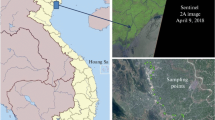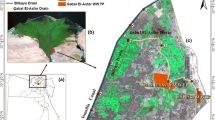Abstract
Indian Remote Sensing satellite (IRS)-1B, Linear Imaging Self Scanner (LISS)-II spectral digital data was analysed to determine the feasibility of quantifying the concentration of suspended solids in the surface water of inland water body, Dal lake, in Srinagar, India. The water samples collected in concurrent with IRS-1B overpass, were analysed to determine the concentration of suspended solids. The results indicate that a positive functional relationship exist between the concentration of suspended solids and the visible wave length bands 1 and 3 and near infrared band 4. It has been observed that as the concentration of suspended solids increase, the spectral response also increases. It is concluded that IRS LISS-H data can be effectively used to quantify suspended sediment concentration in the Dal lake surface water.
Similar content being viewed by others
References
Carpenter D J and Carpenter S M (1983). Modelling inland water quality using Landsat data. Remote Sensing of Environment, 13:345–352.
Choubey V K and Subramanian V (1990). Nature of suspended solids and IRS-1A LISS-I data: A case study of Tawa Reservoir (Narmada basin). Remote Sensing of Environment, 34:207–215.
Choubey V K and Subramanian V (1991). Spectral response of suspended sediments in water under controlled conditions. J. Hydrology, 122:301–308.
Choubey V K (1994). Monitoring water quality in reservoirs with IRS-1A-LISS-I data. Water Resources Management, 8:121–136.
NRSA (1986). Data-User Handbook, Document No. IRS/NRSA/NDC/HB-01/86, National Remote Sensing Agency (NRSA), Hyderabad.
Khorram S and Cheshire H M (1985). Remote Sensing of water quality in the Neuse river estuary, North Carolina. Photogramm. Engg. and Remote Sensing, 51:329–341.
Lindell L T, Stein vail, Johnson O M and Classon T H (1985). Mapping of coastal water turbidity using Landsat imagery. Int. J. Remote Sensing, 6(5):629–642.
Manu L and Robertson C (1990). Estimating suspended sediment concentration from spectral reflectance data. Int. J. Remote Sensing, 11(5):913–920.
Ramsey E W and Jensen J R (1990). The derivation of water volume reflectance from airborne MSS data using in-situ water volume reflectance and a combined optimization technique and radiative transfer model. Int. J. Remote Sensing, 11(6):977–998.
Ritchie J C and Cooper C M (1988). Suspended sediment concentration estimated from Landsat MSS data. Int. J. Remote Sensing, 9:379–387.
Zutshi D P (1987). Impact of human activities on the evolution of Dal lake, Environment Western Himalaya. Gyanodaya Prakashan, 565–577.
Zutshi D P and Vass K K (1982). Limnological studies on Dal lake, Srinagar. Proc. Indian National Science Academy, 48:234–241.
Author information
Authors and Affiliations
About this article
Cite this article
Wani, M.M., Choubey, V.K. & Joshi, H. Quantification of suspended solids in Dal lake, Srinagar using remote sensing technology. J Indian Soc Remote Sens 24, 25–32 (1996). https://doi.org/10.1007/BF03023889
Received:
Accepted:
Issue Date:
DOI: https://doi.org/10.1007/BF03023889




